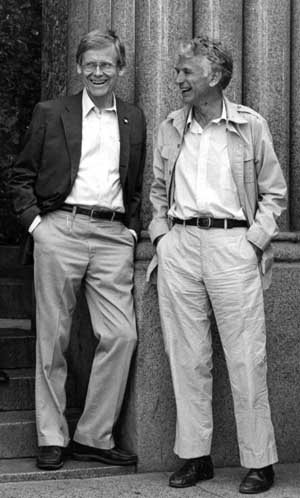Ibsen Nelsen was a preeminent Seattle architect, designer of the Museum of Flight, the Inn at the Market, buildings on the Western Washington University campus in Bellingham, and the elegant Merrill Court Townhouses on Capitol Hill. He died on July 19, 2001. This is a remembrance by Arthur M. Skolnik, architect and former city and state historic preservation officer.
Ibsen Nelsen
Where to begin! Does one think of Ibsen Nelsen as an Architect, a City Planner, a Generalist or perhaps more appropriately a Humanist! Yes, that works for me!
I first met Ibsen in 1969 as one of the members of the first Seattle Design Commission which was created by a vote of the public when they approved the Forward Thrust Bond Package in 1968. Their mandate was to oversee and provide input into the design process of the hundreds of millions of dollars of capital improvements that were about to be unleashed throughout the City. Thus began the first integrated design review process in the state of Washington.
I was fortunate to have had the responsibility of staffing the Commission for a few of those formative years. As I was to find out, Ibsen was the lead proponent of Urban Design criteria for all projects and was the primary Commissioner to ask the tough questions -- mostly taken with a big gulp by the various departmental project managers. Back then, only Ibsen could imagine what the end product would be.
And I was in awe of his ability to politely, directly, and thoroughly get what he asked for! And always noting it in his small black note book!
Now, as I look back on the many suggestions of Ib's, I can say that his input into the urban design of our city has been profound. Due to his leadership, all capital improvements have street trees associated with them; London Plain (Sycamore) trees have become a prominent street tree along our City streets; Retail businesses are abundant along our commercial streets; public amenities such as public art, benches, etc. are typically part of our design concepts; and I could go on and on.
Ibsen made our City more humane, more delightful, and more enjoyable for residents and tourists alike. One wonders what we would have developed into without him. I could not have had a better mentor who provided me with unending enthusiasm for the need to have input and always think out of the box!
I'm sure other colleagues will speak highly of Ib's architectural career, but I do want to add a perspective that follows my earlier comments about his abilities. From the Flight Museum to the tudoresk condominiums within the Harvard/Belmont Historic district, Ibsen favored no trend, no style, no predetermined feature when designing the great variety of projects that he accomplished during his long practice. Each design was a unique concept born out of his ability to understand the environs and community interests and meld them with the clients' needs. But always a quality product. And a pivotal one at that!
Unlike some contemporary designers who often leave some signature in every project as a statement of ownership or portfolio, quality of design and integration into the urban fabric of our great City was his mark, and what a badge to wear proudly.
So, while it's hard to say goodbye to such a great contributor and teacher, one need only tour his projects and visit the capital improvements that he influenced and walk down our most public streets, and you will know that we have been in good hands for all these years and that Ibsen's imprinting on us will carry on into the future for many generation to come.
Good bye dear friend, rest easy and know that you made a difference and the world is a much better place for it!
Fondly,
Arthur M. Skolnik FAIA
July 21, 2001

